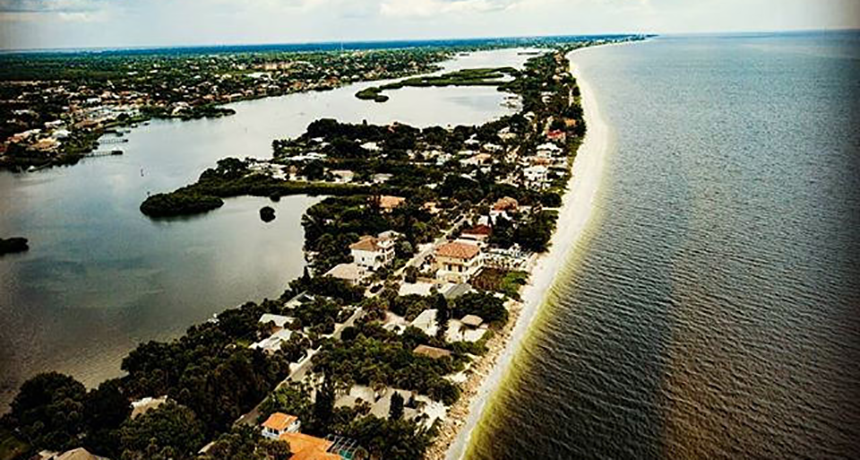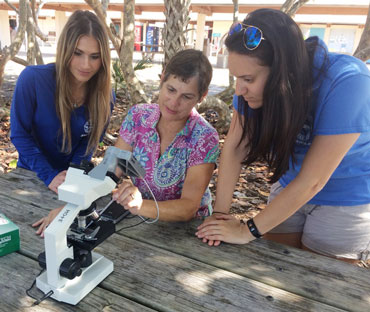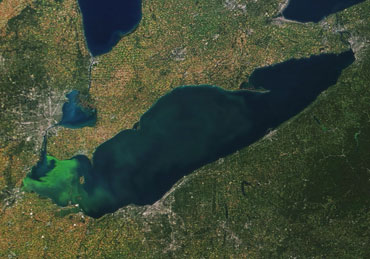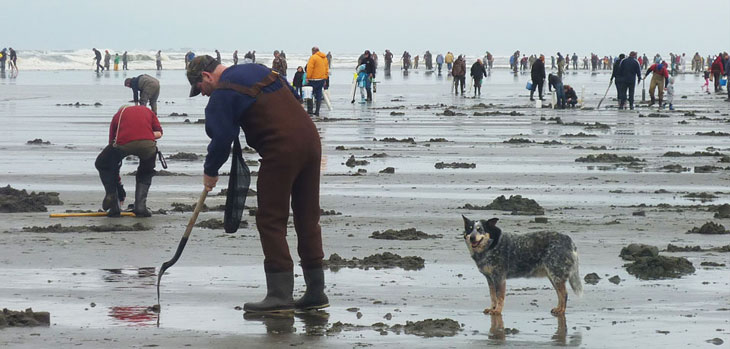New tools aim to better predict blooms of toxic algae
Better understanding the threats from ‘toxic tides’ can protect the environment — and our health

A bloom of harmful algae can be seen just offshore in this summer 2018 image of a Florida shoreline.
Robin Hamman/Flickr (CC BY-NC 2.0)
The stench of thousands of dead, bloated fish hung over the beaches of western Florida for months in 2018. The fish were casualties of an algae bloom — an uncontrolled growth of small organisms. Such blooms hit the Gulf of Mexico’s coastlines almost every year.
Called a red tide, this year’s bloom has been particularly intense — and toxic. The algae that turn the water a murky reddish tint also emit a poison. It can cause breathing problems for people — and kill sea creatures. Dolphins and endangered sea turtles may turn up among the dead.
“Algae” is a catch-all term used for a variety of water dwellers that use photosynthesis to make energy from the sun. They can range in size from bacteria and other single-celled organisms to larger algae, such as kelp.
Not all algae are bad. But harmful algae blooms — abbreviated HABs — can be sickening, even deadly. That’s why scientists are at work to better predict when and where blooms might emerge. Many systems are being developed to forecast blooms. Most can predict such toxic tides only three to seven days off.
Climate change could further worsen toxic tides, the U.S. Environmental Protection Agency warns. Those changes could include warmer water temperatures, growing salinity and higher sea levels of carbon dioxide.
And Florida’s red tide is not the only bloom plaguing U.S. waters. Other types of toxic tides are also appearing ever more frequently. They also are popping up in more places and lasting longer.
Toxic threats
Scientists are working on ways to predict blooms of toxic algae using satellite data, computer analyses and knowledge about the species involved. Take a look at the different microscopic organisms that threaten U.S. waters.
Tap or click circles to explore.
Breathing in Florida’s red tides
The best known toxic tides are caused by Karenia brevis (Kaa-REN-ee-uh BREV-iss). These fragile, single-celled algae create red tides. When their cells die or become damaged by waves, they release poisons. These are called brevetoxins (BREV-eh-tox-ins).
During a bloom, the algae’s poisons can enter the air. People walking along an affected beach “might cough or sneeze or have itchy eyes,” notes Tracy Fanara. She’s a research scientist at Mote Marine Laboratory & Aquarium in Sarasota, Fla. A red tide’s effects can be worse for people already struggling with lung issues, such as asthma.
In September 2017, Mote began testing a program called HABScope. It trained 20 volunteers to sample waters daily at various beaches affected by a red tide. These citizen scientists placed three drops of seawater under a microscope, then recorded a 30-second video of the algae swimming around.
A computer program can analyze these videos to count the algae in each sample. Those data, along with information on winds and water currents, then go into a computer model. It was created by the National Oceanic and Atmospheric Administration (NOAA). This computer program can then predict red-tide threats to breathing over the next few days at each beach.
Across the Gulf of Mexico, the University of Texas Rio Grande Valley is running a similar program. It’s called Red Tide Rangers.
Counting K. brevis cells in a water sample used to take an expert an entire day. The new program “allows a volunteer to do this within five minutes,” Fanara says. “Hopefully with this real-time data that we’re providing, we can get better and more accurate” forecasts.
Seafood can turn toxic
The Gulf of Maine is home to another nasty algal species. People who eat shellfish tainted with this Alexandrium catenella (Al-ex-AN-dree-um Kaa-tuh-NEL-uh) may become paralyzed — even die.
The single-celled organism paddles around using two whip-shaped “oars” known as flagella. Blooms of this alga are “incredibly toxic,” notes Richard Stumpf. He’s a NOAA oceanographer based in Silver Spring, Md. Between 2007 and 2009, A. catenella left eight people in Maine with paralytic shellfish poisoning. All had eaten shellfish from closed areas.

These algae flourish in the warm waters off Maine from July through September. Blooms of the species will consume available nutrients until they run out. Then the algae reproduce. Their offspring clump, forming cysts that sink to the ocean floor. There they’ll rest until the next warm season.
For about 12 years, scientists have been gathering seafloor samples each October and November at some 50 affected sites. The cysts in each sample are counted. These data then go into a computer model to forecast how big next year’s bloom might be, explains Stumpf. He leads the forecasting project.
But his team can’t predict exactly which areas will be most affected. For that, the team produces another, shorter-term forecast. It relies on wind conditions and estimates of local conditions for three to seven days out.
Neither forecast can tell how toxic a bloom might become. That’s a goal for Dennis McGillicuddy. He’s an oceanographer at the Woods Hole Oceanographic Institution in Massachusetts. “Shellfish are basically little bio-accumulators of the toxin,” he says. They can hold onto the poison long after the algae are gone.
McGillicuddy’s team is working on a computer model to predict how many toxic algal cells shellfish might be exposed to over a summer. That should help the researchers figure out how long it will take those shellfish to flush the toxins from their bodies. And shedding those toxins isn’t quick. It may take months — even years.
The blue-green blooms of Lake Erie
Over the past several years, a thick, slimy foe has been plaguing Lake Erie. It’s a cyanobacterium, a type of blue-green algae. And it “is gross,” Stumpf says. “There’s no other way to describe it.”

These algae live in open waters of all U.S. states. Scientists are now working to predict when they may bloom into toxic tides. That way officials can figure out how much to treat tainted waters. Cyanobacteria produce toxins known as microcystins. These produce skin rashes, vomiting and diarrhea.
Erie, the fourth-largest U.S. lake, provides drinking water to roughly 11 million people. During its warmest months, this lake also hosts the nation’s biggest cyanobacteria blooms. Communities treat the water that will be used for drinking. But when a bloom’s toxicity has been underestimated, the water may not be treated enough.
In 2014, 110 people were sickened after drinking undertreated water.
The intensity of a bloom is directly related to how much phosphorus enters a lake after running off of farm fields. That mineral is a fertilizer of crops (and these algae). Heidelberg University in Tiffin, Ohio, runs a river monitoring program that samples waters flowing into Lake Erie. It measures phosphorus levels several times a day, Stumpf notes. Researchers use the data to predict seasonal blooms.
Stumpf and other researchers also produce a short-term forecast for a toxic tide of this alga. It’s based on satellite images of the bright green blooms together with data on phosphorus levels and winds. That forecast can point to where within the lake a bloom will likely emerge during the next few days.
Some blooms can poison your memories
Another type of toxic tide often hits the West Coast of North America. Blooms of this Pseudo-nitzschia (Sue-doh NIT-zhee-uh) can show up anywhere from Alaska down to southern California. Some species of the rod-shaped algae secrete a poison known as domoic acid. People who eat fish or shellfish tainted with the toxin may develop permanent brain damage.
A primary symptom: People no longer can make short-term memories. High doses of the poison can bring death. And humans aren’t the only ones at risk. Each year, dozens of marine mammals suffer brain damage after blooms poison them with domoic acid.
Today “is a really pivotal moment” for developing ways to forecast toxic blooms, says Clarissa Anderson. She’s an oceanographer at the Scripps Institution of Oceanography in La Jolla, Calif. She has spent the past decade developing a way to predict Pseudo-nitzschia’s domoic-acid levels. Those forecasts should work for locations up to 1,000 kilometers (620 miles) off the Oregon and California coasts.
Called C-HARM, the three-day forecasts rely on satellite photos that show chlorophyll patterns, ocean temperatures and sea-salinity levels. Three different computer models integrate these data to forecast the toxic tides.
Anderson also puts out a monthly bulletin. It estimates the likelihood of a Pseudo-nitzschia bloom showing up at various sites.
As toxic tides become more common, it becomes ever more important to predict which beaches and coastal areas may get hit. Only then can communities and workers safely work, play and enjoy the bounty of their coastal waters.








